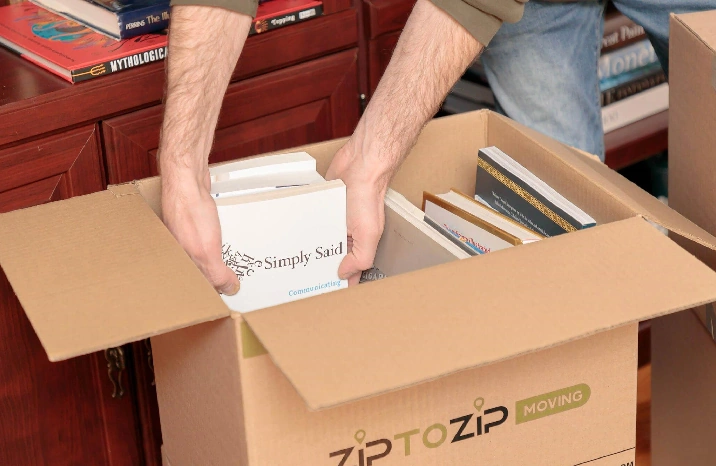Shipping books safely helps them arrive in perfect shape. Whether you’re selling used books online or sending new ones as gifts, using the right packing method keeps pages neat and covers clean.
In this guide, I’ll walk you through each step of packing, protecting, and shipping books the right way.
How to Pack & Ship Books
To ship books safely, it all starts with using the right materials and packing smart. Here’s a step-by-step guide to help you do it right:
1. Select the Right Packaging Materials
Choosing the right packaging materials for book shipping boxes is the first step you must consider. Here are a few material options:
- Strong Cardboard Boxes: These sturdy boxes protect books from bending or crushing.
- Bubble Wrap: Wraps around books to cushion them from bumps.
- Packing Tape: Good-quality tape keeps the box sealed tightly during shipping.
- Packing Paper or Newspaper: Fills space so books don’t move around.
- Plastic Bags: Help keep books dry if the box gets wet.
For example:
- Single book: Use a padded flat mailer or a small book box.
- Multiple books: Choose a corrugated box that holds them snugly.
- Heavy books: Double-walled boxes are best for added strength.
Choosing the right box size helps avoid damage during transit.
2. Secure the Books
Wrap each book with brown paper or bubble wrap to keep it safe during shipping. For old or rare books, use acid-free paper to protect the pages and covers.
Tape the wrap in place so it doesn’t come loose.
You can also place the book in a custom book box or a plastic bag to protect it from water or moisture during shipping.
3. Arrange the Books
Lay the books flat inside the box. Put the biggest and heaviest books at the bottom, and lighter ones on top. Wrap each book and use cardboard or plastic sheets between layers for better safety.
If a book is extra fragile, stand it upright with cardboard on the sides.
4. Add Cushioning Inside
Fill gaps around the books with box inserts:
- Use bubble wrap or air pillows.
- For uneven spaces, crumple paper or packing peanuts.
- Make sure books don’t move around when you shake the box lightly.
Good cushioning keeps books safe during handling and shipping.
5. Seal and Label the Box
Use strong packing tape to seal all the edges of the box. Add a second layer of tape for large boxes to make it extra secure. This keeps the box from opening during shipping.
Write the full address clearly on the box. If the books are fragile, put a “FRAGILE” sticker on the box. Cover the label with clear tape to protect it.
Choose the Right Shipping Carrier
Choosing the best carrier affects your cost and delivery time. Here are some common options:
UPS
- Great for heavy, multiple books.
- Offers tracking and reliable delivery.
- Use UPS Ground for affordable shipping over short to mid distances.
- Great for shipping books internationally.
- Offers a variety of shipping speeds.
- Cost varies by size, weight, and destination.
USPS
- First Class Mail is best for lightweight books.
- Priority Mail is good for heavier or more books.
- Flat-rate book boxes are cost-effective for heavier shipments.
- Its media mail is cheaper than other media mail options.
FedEx
- FedEx Ground and Home Delivery are good for heavier packages.
- FedEx Express helps when you need faster delivery.
- Tracking and insurance options are available.
- Reliable and affordable option.
DHL
- Best for international shipping.
- Options include E-commerce Parcel and Express Services.
- Be sure to include customs forms, and be aware of delivery times.
- Fast delivery and their efficient international delivery services for multiple books.
How to Ship Books Cheap
Shipping books can be costly, especially when they’re heavy or shipped far.
To save money, it helps to know a few smart tips. Below are some easy ways to ship books cost-effectively while keeping them safe during transit.
- Use Media Mail (U.S. only): This USPS option is the most affordable way to ship books domestically.
- Choose lightweight packaging: Use padded envelopes or slim boxes to reduce shipping weight.
- Compare shipping rates: Use online tools to compare carriers like USPS, UPS, and FedEx for the best price.
- Buy postage online: Services like Pirate Ship or ShipStation often offer discounted shipping rates.
- Ship in bulk when possible: Sending multiple books in one package can lower the per-book cost.
Conclusion
Shipping books may seem simple, but proper packing and smart shipping choices can make a big difference. Whether you’re sending a single book or a bulk order, using the right materials, protecting against damage and moisture, and choosing cost-effective shipping options will ensure your books arrive safely and affordably.
